The PiCAT, or Pre-screening internet-delivered Computer Adaptive Test, is a multiple-choice test administered by the United States Military Entrance Processing Command. The purpose of the PiCAT exam is to determine qualifications for enlistment in the U.S. Armed Forces, and it also helps in identifying potential career paths within the military.
Unlike its close counterpart, the ASVAB, the PiCAT is administered digitally through the candidate’s very own computer. The test is adaptive, meaning that each consecutive question will present a difficulty level based on the candidate's previous response.
This page offers free PiCAT practice test questions from all the different PiCAT sections, along with tips and valuable techniques for answering correctly and quickly.
Begin Your Studying With Free PiCAT Practice Test Questions
Similar to the ASVAB, the PiCAT test includes 145 questions in 9 topics (10 if you separate auto and shop information). Start studying by first familiarizing yourself with the different topics. While some questions may seem easy at first glance, you will soon get a sense of how important thorough preparation with practice tests is.
Another important aspect to consider is the PiCAT verification test. As this exam validates your initial test, failing it means taking the full ASVAB test. Therefore, proper practice is vital for both exams. You can read all about it in our Army PiCAT guide.
PiCAT Mathematics Knowledge Sample Questions
Mathematics Knowledge measures a person's grasp of fundamental high school mathematical principles. Let’s look at a few examples.
1. For all x, (x - 4)(x + 4) = ?
A. x2 + 2x - 16
B. x2 - 2x + 16
C. x2 + 16
D. x2 - 16
E. ±4
Answer:
The correct answer is D.
This is solved using the connection a2 - b2 = (a + b)(a - b).
Hence (x - 4)(x + 4) = x2 - 16.
If you do not remember the formula by heart this can also be solved by opening the brackets:
(x - 4)(x + 4) = x2 + 4x - 4x – 16 = x2 - 16
2. 7.4 × 102 decimeters equal:
A. 74 centimeters
B. 740 centimeters
C. 7,400 centimeters
D. 74,000
E. 740,000
Answer:
The correct answer is 7,400 centimeters.
A decimeter is a tenth of a meter or ten centimeters.
7.4 × 102 = 740 (decimeters).
740 × 10 = 7,400 (centimeters).
3. If y=2x+3, what is the value of y when x = 5?
A. 10
B. 13
C. 15
D. 25
Answer:
Plugging in x = 5, we get y=2(5)+3=10+3=13.
As can be seen, Mathematical Knowledge assesses basic arithmetic operations, mathematical formulas, working with units of measurement, and more. Solid math knowledge and quick calculations are key to success in the PiCAT test. Mathematical questions are best improved by repetitive practice, and you can find many PiCAT practice tests, simulations, and guides in our all-inclusive ASVAB PrepPack.
Next, we’ll cover another mathematical section of the PiCAT test questions — Arithmetic Reasoning. Approaching word problems that require calculations to succeed poses new challenges, different from those described in MK. Let’s continue!
PiCAT Arithmetic Reasoning Sample Questions
Arithmetic Reasoning evaluates an individual's ability to solve common arithmetic problems one might encounter in day-to-day life. Let’s look at three different examples.
4. It took Sarah six minutes to drive to the post office, eight minutes to find parking, and five minutes to choose stationery; she then waited on line for seventeen minutes.
How many minutes passed from the time Sarah left her house until she completed her errand at the post office?
A. 39
B. 33
C. 36
D. 31
Answer:
The correct answer is 36.
If we add up all of the time that it took Sarah from the time she left her house until she completed her errand, we will find that 6+8+5+17 = 36.
5. There are six printers at "Today's news" newspaper, all printing at the same constant rate. When working together, the six printers can complete the printing of tomorrow's newspaper within 12 hours.
If the owner wishes to reduce the printing time to 8 hours, how many other printers will he need to purchase, each with the same constant rate?
A. 1
B. 3
C. 6
D. 5
Answer
The correct answer is B.
The approach to this type of question is to work in two steps:
(1) Finding the individual rate of work per printer
(2) Finding the additional number of printers needed
Step 1- The work rate of 6 printers together is one newspaper/ 12 hours => 1/12. Since each printer works at the same rate, we can say that each printer contributes 1/6th of the total work rate, meaning: (1/12)/6 = 1/72, or one printer/ 72 hours.
Step 2- We will insert what we have learned in Step 1 and the required time (hours) into the basic formula:
Work = rate*time.
1 newspaper = number of printers*(1/72) *8 hours
=> 1 = number of printers*1/9
=> Number of printers = 9
The number of printers includes the original six printers + the additional printers required. Thus, 9 - 6 = 3 additional printers.
6. What was its original price if a shirt costs $20 after a 20% discount?
A. 24$
B. 25$
C. 28$
D. 30$
Answer:
The correct answer is B.
Let's assume the original price is X. 80% of X (because there's a 20% discount) is $20. So, 0.8X = $20. Dividing both sides by 0.8 gives X = $25.
Arithmetic Reasoning questions assess basic calculations and simple formulas while reading through passages. The most important key to success in this section is to quickly build a formula with all the relevant data or use the answers to assess which is applicable to the data in the question.
Practice different answering strategies with hundreds of questions in our All-Inclusive ASVAB PrepPack, featuring content and structure identical to the PiCAT.
The Armed Forces Qualification Test (AFQT) Scoring:
The AFQT is the overall PiCAT score required for successfully enlisting in the US military. The scoring of the AFQT calculates four sections — Mathematical Knowledge (MK), Arithmetic Reasoning (AR), Word Knowledge (WK), and Paragraph Comprehension (PC). The minimal score required for each branch is as follows:
- Air Force – 31
- Army – 31
- Marine Corps – 32
- Navy – 35
- Coast Guard - 36
The required scores are for High School Seniors/High School Diploma Recipients. For GED Holder, the minimal score for most branches is 50, which is overall a good score to strive for.
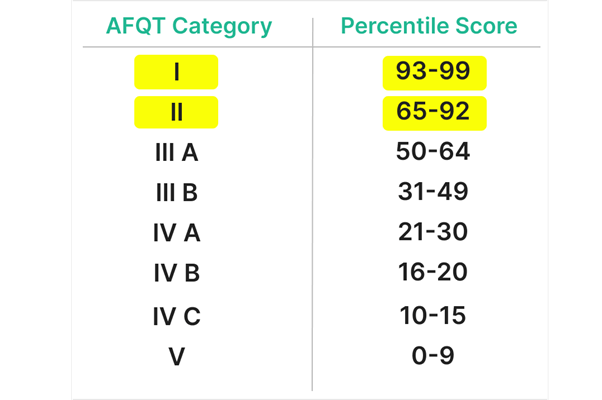
Score High in the AFQT Categories With Accurate and Professional Prep
Optimize your studying for the PiCAT exam with our detailed kit:
- Introduction Simulation and in-depth guides and explanations
- Tailored studying methodology for weakness-focusing
- ASVAB and AFQT simulations for perfecting your understanding
The next section of the PiCAT questions is Word Knowledge. It is the first of the two Verbal sections.
PiCAT Word Knowledge Sample Questions
The Word Knowledge section assesses the test-taker's command over the English language, specifically focusing on vocabulary.
7. HUNGRY is the opposite of:
A. Tasty
B. Full
C. Happy
D. Ugly
Answer:
The correct answer is B.
Hungry is a word used to describe someone who has a desire for food, while full is a word used to describe someone whose appetite is satisfied.
8. The new program was sanctioned by the board of education.
You can replace the underlined word with:
A. Explained
B. Authorized
C. Divided
D. Offered
Answer:
The correct answer is B. Authorized.
The word sanctioned has two meanings: (1) An action that has been given official approval (in this case, by the educational board), (2) The imposition of a sanction or a penalty.
Option B (authorized) adheres to the first meaning.
9. Which of the following is an antonym for "benevolent"?
A. Malevolent
B. Kind
C. Generous
D. Altruistic
Answer:
The correct answer is A.
"Benevolent" means showing kindness or goodwill. "Malevolent" means having or showing a wish to do harm to others, making it the antonym.
The Word Knowledge section contains three types of questions: Synonyms, Antonyms, and Context. Reading, attempting to use different words in different contexts — and of course, specific and broad practice is the key to excellent test results. Find hundreds of Work Knowledge questions with detailed explanations in our All Inclusive ASVAB PrepPack.
Let’s move on to the final section to be included in the AFQT score — another verbal section, Paragraph Comprehension. While WK assesses straightforward knowledge, PC assesses your ability to understand, summarize and apply reason for short paragraphs of text.
PiCAT Paragraph Comprehension Sample Questions
Paragraph Comprehension delves into an individual's ability to interpret and understand written information.
10. The brain is our most complex organ, in terms of connections and microscopic structure. It is heterogeneous, with many areas and networks differing from one another in function. And, what is more, the brain is a ‘hidden entity’, embedded in an envelope made of bones, the skull. Brain imaging really came to age in medicine 40 years ago, thanks to computers. The technologies of structural anatomy like computerized tomography and magnetic resonance imaging have brought about a revolution in neurology by showing the lesion and its topography.
What is not true about the human brain?
A. Microscopic structure
B. Heterogenous
C. Hidden entity
D. The largest organ
Answer:
The correct answer is D.
Note that this question asks what is NOT found in the passage. Reviewing the features of the brain mentioned:
Heterogeneous (answer B), microscopic structure (A), and hidden entity (C) are all mentioned. Only the fact that it is our largest organ (D) isn't mentioned; so, this is the correct answer.
11. Pay television is now under threat, especially in America. Prices have been driven so high at a time of economic malaise that many people cannot afford it. Disruptive, deep-pocketed firms like Amazon and Netflix lurk, whispering promises of internet-delivered films and television shows for little or no money. It is unclear whether the lure of such alternatives or poverty is causing people to cancel their subscriptions. But the proportion of Americans who pay for TV is falling.
How many possible explanations are offered for pay- TV's fall?
A. None
B. One
C. Two
D. Three
Answer:
The correct answer is C.
The passage offers two explanations for the decline of pay TV: the rise of internet-delivered films and television firms such as Netflix and Amazon and the high rate of subscriptions.
12. "The library is a place of learning. Beyond books, it offers resources like computers and classes to the community."
Which statement is true based on the paragraph?
A. The library only has books.
B. The library offers computers to the community
C. The library dislikes technology
D. The library only serves students
Answer:
The correct answer is B.
The paragraph mentions that the library offers resources like computers to the community.
Paragraph Comprehension questions assess your ability to quickly read, understand and apply reason/summarization/responses to different questions regarding short text. While reading books and articles is a great way to improve your abilities — it is possible to improve your scores using different methods, such as reading the question first and then looking for the answer in the text. Find hundreds of Paragraph Comprehension texts and questions with detailed explanations in our All Inclusive ASVAB PrepPack.
You can further practice your skills with our Free Civil Service Exam.
Additionally, if you would rather take the ASVAB, make sure to thoroughly practice before taking the test, and read about the requirements of each of the military branches, including the Air Force, Coast Guard, Marine Corps and Army.
The Line (Composite) Scores
The line (Composite) Scores: a combination of scores from various individual PICAT subtests. These composite scores are used to determine qualification for specific military jobs, known as Military Occupational Specialties (MOS) in the U.S. Army or ratings in the Navy, for example.
Each branch of the U.S. military has its own set of line scores calculated from specific combinations of PICAT subtests. These composite scores provide more detailed information about a candidate's aptitudes in particular areas beyond the general measure provided by the AFQT score. You can learn everything there is to know about the composite scores on our PiCAT Scores page.
What can you do to achieve your best possible scores on the PiCAT?
Following in this PiCAT practice test are the additional five sections which are included in the composite score. Make sure to check which sections are relevant to your preferred position before beginning your practice. We will start with General Science, which assesses your basic knowledge in various scientific fields.
PiCAT General Science Sample Questions
General Science offers a broad overview of both the physical and biological sciences. Serving as a foundational assessment, this section evaluates a test taker's knowledge in areas such as Earth science, biology, chemistry, and physics. Let’s dive in with a few example questions.
13. What does an amperemeter measure?
A. The voltage
B. The current
C. The power
D. The resistance
Answer:
The correct answer is B.
An amperemeter measures amperes (A). Since the ampere measures current, the correct answer is B.
14. A ball thrown horizontally slows due to:
A. Mass
B. Gravity
C. Inertia
D. Friction
Answer:
The correct answer is D.
Mass: Mass is a measure of the amount of matter in an object or substance, typically expressed in units like kilograms or grams.
Gravity: Gravity is the natural force that attracts objects toward the center of the Earth or toward any other massive body.
Inertia: Inertia is an object's inherent resistance to changes in its state of motion or rest.
Friction: Friction is the force that opposes the motion of two surfaces sliding or trying to slide across each other. Therefore, the correct answer is D.
15. Which of the following is NOT a mammal?
A. Whale
B. Dolphin
C. Bat
D. Shark
Answer:
The correct answer is D.
While whales, dolphins, and bats are all mammals, sharks are fish, and therefore, not mammals.
General Science questions vary and require vast, yet basic, knowledge in the physical, chemical, biological, and other common scientific fields. The meaning is – that the more knowledge you have in different fields, the easier it will be to either answer or narrow down options to provide a calculative guess if you are unsure of the answer. You can find many General Science questions with explanations in our All-Inclusive ASVAB PrepPack.
The next section, Mechanical Comprehension, includes mostly Physical subjects in basic mechanics. Unlike General Science — this section may include a large portion of calculative questions regarding common equations in mechanics. Let's continue.
PiCAT Mechanical Comprehension Sample Questions
Mechanical Comprehension delves into principles associated with simple machines, structural support, properties of materials, and mechanical motion.
16. A hockey puck is sliding on an infinite plane of ice. The friction between the puck and the ice is zero, as well as the friction between the puck and the air.
What will affect the time required for the hockey puck to come to a full stop?
A. The puck's weight
B. Gravity
C. The puck's initial velocity
D. Nothing, it will never stop
Answer:
The correct answer is D.
With no friction, the puck is sliding with no forces applied to it apart from its weight. Since the direction of the weight is downwards, it will not affect the velocity which is perpendicular to it (the ice is a horizontal plane). With no other forces applied to the puck, it will never stop due to its inertia (its resistance to a change in its motion). According to inertia, the puck will slide forever without a decelerating force.
17. A perfectly smooth tube with a constant rate of flow of water is given. A segment of the tube with two pressure gauges attached is shown in the diagram below.
Which pressure gauge will indicate a higher value?
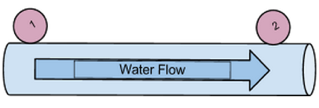
Answer:
The correct answer is B.
Following Bernoulli's principle, in a steady flow of a fluid (with negligible compression due to pressure and negligible friction due to viscous forces — like water), we have the equation:

where P = pressure, ρgh = potential energy per volume, ½ρv2 = kinetic energy per volume.
Since the area of the tube's cross-section is unchanged throughout, and the rate of water flow is constant, we may conclude that the velocity of the water remains constant (Rate of flow = Velocity*Area). Thus, the kinetic energy remains constant throughout the tube.
The pressure gauges are situated at an identical height; therefore, their potential energy is equal. According to Bernoulli’s principle, the pressure at point 1 must be equal to the pressure at point 2.
18. A pulley system is used to:
A. Increase friction
B. Increase electrical conductivity
C. Amplify sound
D. Change the direction or magnitude of a force
Answer:
The correct answer is D.
Pulleys are mechanical devices that change the direction or magnitude of a force applied to a load.
Mechanical Comprehension questions may include either knowledge of basic rules and concepts in mechanics and physics or the ability to utilize them for calculations, like the second example. You must have a great knowledge of the basic formulas and concepts to answer knowledge questions accurately. You can find a comprehensive Mechanics guide, questions, and detailed explanations in our All-Inclusive PiCAT PrepPack.
Next up is Electronics Information. Very similar to Mechanical Comprehension – it encompasses the electricity portion of physics in the PiCAT exam. Concepts, knowledge, tools, and calculations must be performed in this section.
PiCAT Electronics Information Sample Questions
Electronics Information focuses on electronic systems and devices' fundamental principles and concepts.
19. In which direction does the electric current flow in an electric circuit?
A. From the negative to the positive terminal
B. From the positive to the negative terminal
C. In the opposite direction of the positive-charge flow
D. In the same direction as the positive-charge flow
Answer:
The correct answer is B.
Conventional current is designed to flow in the same direction as positive charges. In metals, where the charge carriers (electrons) are negative, conventional current flows in the opposite direction of the electrons. In conductors, where the charge carriers are positive, conventional current flows in the same direction as charge carriers.
Options C and D present the exact opposite of that reasoning.
In a common electrical wired circuit, negatively charged electrons flow from the negative terminal to the positive terminal. According to the above definition, the electric current flows in the opposite direction as the electrons — from the positive terminal to the negative terminal.
20. A force of 10 N(Newton) compresses two identical springs in parallel for 8 cm. What will be the total distance that four identical springs in series are compressed?
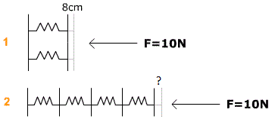
Answer:
The correct answer is D.
An external force exerted on a spring cause it to compress or extend.
The distance of compression or extension is directly and linearly proportional to the force exerted on the spring, i.e., doubling the force causes the spring to stretch or compress twice as much.
When identical springs are connected in parallel, the applied force is divided equally between them. Consider the image below:
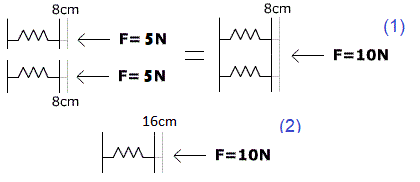
Each of the two springs connected in parallel is subjected to a force of 5 N that compresses each spring by 8 cm (1). On the other hand, had only one spring been subjected to a 10N force, it would compress by 16 cm (2).
When identical springs are connected in series, each spring's entire force is applied separately. Consider the image below:

Each of the four springs in the series is subjected to a force of 10 N, and therefore resembles the case in image (2), compressing 16 cm. Thus, the total compression is the combined compression of all four springs: 4 X 16 cm = 64 cm.
21. A power supply outputs 15V at 3A. How much power does it deliver?
A. 5W
B. 18W
C. 45W
D. 50W
Answer:
The correct answer is C.
Power P=V × I = 15V × 3A = 45W.
Electronic Information questions test your knowledge of electricity and your ability to perform calculations. You must come to the test with broad knowledge of electricity concepts, as well as practice many calculation questions prior to being able to perform them accurately. You can find many Electrical Information questions with explanations in our All-Inclusive PiCAT PrepPack.
How to Pass the PiCAT With a High Score
Our experts developed a 3-step formula to ace the PiCAT and ASVAB exams. It includes a proven study plan to help you pass every exam subtest, even if you’ve been out of school or college for several years.
- Step 1: Start with a Full Introduction Simulation to identify your strengths and weaknesses. Read through the instant score report highlighting your weaker areas to form a personalized prep plan based on your score and preferred lines.
- Step 2: Solve focused practice drills for each section you need to improve. These include step-by-step explanations and guides that demonstrate how to face every question.
- Step 3: Finish your preparation with full ASVAB and AFQT Practice Simulations and see your amazing progress. If some topics still need improvement, you’ll continue practicing until your final score is excellent.
For the beginning price of 79$, you can start your practice today.
The next section comprises two subjects combined – Auto and Shop (in the CAT PiCAT, they may be in two different sections – each is as short as half of a full section). This section tests knowledge of automobiles and workshops, which, on the one hand, is very specific, yet requires wide knowledge in those fields. Let's continue.
PiCAT Auto and Shop Information Sample Questions
Automotive and Shop Information measures your knowledge of mechanical systems and parts, as well as basic shop tools.
A. They have better heat dissipation than drum brakes.
B. They use a rotor and caliper mechanism.
C. They are commonly used for rear brakes in heavy trucks.
D. They are generally more efficient than drum brakes in wet conditions.
The correct answer is C.
While disc brakes are widely adopted for their efficiency, drum brakes are still commonly used for the rear brakes in many heavy trucks due to their parking brakes integration and cost-effectiveness.
A. It's a type of milling cutter.
B. It's commonly used in a milling machine.
C. It's primarily used for drilling operations.
D. It has cutting teeth on its end and on its sdies.
The correct answer is C.
While end mills can perform drilling operations, they are primarily designed for milling or cutting operations.
Auto and Shop information questions demand broad general knowledge about these topics. If you don’t have any previous experience in these fields, your best option will be to practice as many similar-to-test questions. This will increase your chance of facing similar topics on the test and will enhance your overall understanding. You can practice many Auto and Shop questions with full explanation in our All-Inclusive ASVAB PrepPack.
PiCAT Assembling Objects Sample Questions
Assembling Objects is designed to test spatial awareness and visualization skills. PiCAT takers are tasked with understanding how different parts fit together, making it an essential measure for roles that require assembling or disassembling equipment.
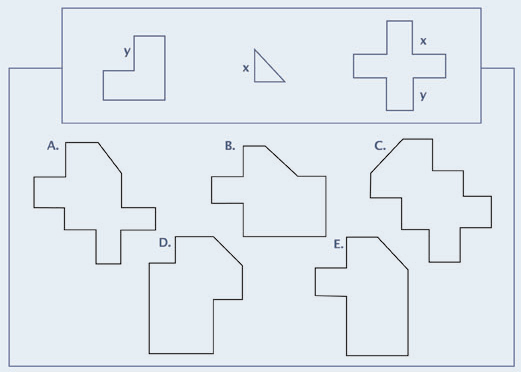
Answer:
The correct answer is E.
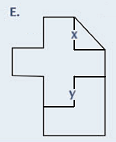
25. Which of the following figures includes all the following objects assembled? Note that the labeled (x,y,z) must be placed together.
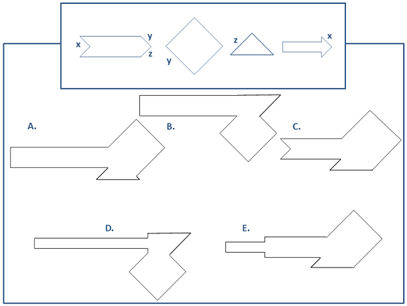
A
B
C
D
E
Answer:
The correct answer is E.
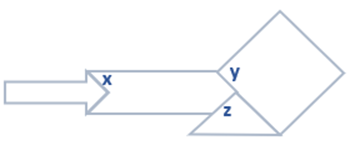
26. Which of the following figures includes all the following objects assembled? Note that the labeled (A,B,C) must be placed together.
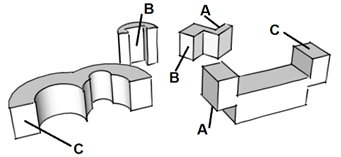

1

2

3

Answer:
The correct answer is B (figure 2).
Look at the ends marked A. If the ends marked A were put together, how would they look? Of the five pictures, only pictures 1 and 2 have the ends marked A put together. Now look at the ends marked C. Which of the pictures 1 and 2 show that the two places marked C are put together? Of the two, only picture 2 has the places marked C put together.
Therefore, picture 2 is the correct answer.
Assembling Objects questions are unique – and with 2D and 3D assembling requirements – you must be able to visualize the object and quickly decide on the correct answer. Prior practice is required to be able to visualize images on screen and assemble them to respond accurately. You can find hundreds of Assembling Objects questions with explanations in our All-Inclusive ASVAB PrepPack.
Get To Know the PiCAT Test Inside Out
- 9 test topics (10 if you separate auto and shop information)
- 145 Questions
- Untimed
- Unproctored and can be taken everywhere, even from home!
- You will have to take a 20-minute proctored verification test to make it your official ASVAB score
The PiCAT subtests are:
- General Science (GS): Assesses physical and biological sciences knowledge.
- Arithmetic Reasoning (AR): Tests ability to solve arithmetic word problems.
- Word Knowledge (WK): Measures understanding of word meanings.
- Paragraph Comprehension (PC): Evaluates the ability to understand written material.
- Mathematics Knowledge (MK): Assesses high school math principles knowledge.
- Electronics Information (EI): Measures knowledge of electronic systems and devices.
- Auto and Shop Information (AS): Tests knowledge of automobile mechanics and shop practices.
- Mechanical Comprehension (MC): Evaluates understanding of basic mechanical principles.
- Assembling Objects (AO): Assesses spatial visualization and tool recognition.
Achieve Top-of-the-class scores and broaden your opportunities by reading how these sections are integrated into the scoring method and additional important information about the PiCAT exam.
Note: Since the test results are valid for 5 years, it is very important to achieve a high score on the first attempt. Professional preparation opens up opportunities for the examinee to advance in various roles during the 5 years following the test.
We recommend reading our Free ASVAB Practice Test and our ASVAB Guide to better understand the tests and the differences between them.
We hope these PiCAT practice questions helped you get a sense of what's ahead. If you are interested in a military career, optimizing your answers on the PiCAT is the first step. This will certainly provide you with the best opening cards.
You can learn about other military assessments by going to their dedicated pages:
Our All-Inclusive ASVAB PrepPack Includes Comprehensive Preparation Material, Including:
- Introduction simulation to create your personalized practice plan.
- Extensive practice for the AFQT sections including guides.
- Full AFQT and ASVAB simulations.
- In-depth practice and guides for the additional sections.
Discover Our PiCAT and ASVAB Practice Tests and Guides:
ASVAB Scores | ASVAB Waiver | Air Force ASVAB Prep | Air Force ASVAB Score | Air Force Cybersecurity | Navy ASVAB Practice Test | OAR Test Prep | ASVAB Practice | PiCAT Scores | Army PiCAT Prep | AFOTQ Practice | EDPT Test | EDPT Practice Test | U.S. Army Recruitment Process | Civil Service Practice Test | Police Practice Test




